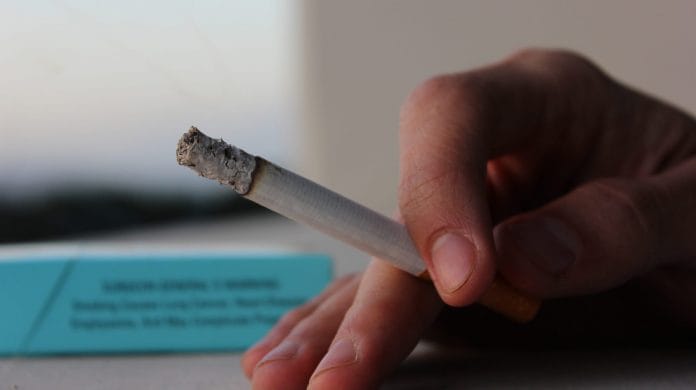Smoking not only invites lung cancer but also early wrinkles, pigmentation, dull skin, allergies, and more, whether actively or passively.
Research published in the Nutrition Journal in 2004 indicates that smokers tend to have lower levels of antioxidants in their bodies compared to non-smokers, primarily due to nutrient depletion. This deficiency can lead to a dull and grey complexion. Moreover, smoking decreases vitamin A, which is required for the growth of new skin cells. Therefore, alongside the serious statutory warning of “Lung cancer picture on the box,” the consequences of a dull complexion and pigmentation, which can make one appear older than they are, should also be well known.
Indians have darker skin, and smoking stimulates the production of melanocytes, the cells responsible for producing melanin, the pigment that gives skin its colour. As melanin production increases in smokers, there is a tendency for it to accumulate over time, resulting in age spots and dark patches on the skin. Studies suggest that the chemicals in cigarette smoke may also contribute to dull skin, particularly on the face. This combination of factors not only affects the skin’s appearance but can also accelerate signs of aging.
Smoking exposes your body to approximately 5,000 harmful chemicals. Even shisha or hookah can contain high levels of lead, arsenic, and nickel. In fact, hookah smoke may contain 36 times more tar and 15 times more carbon monoxide than a single cigarette. Vaping and e-cigarettes contain nearly 2,000 chemicals, according to research from Johns Hopkins University.
The combination of nicotine, carbon monoxide, and free radicals in cigarette smoke gravely impact skin health. Nicotine constricts small blood vessels, reducing blood flow to the skin. This results in a pale and dry appearance. Carbon monoxide makes it worse by binding to haemoglobin in red blood cells more easily than oxygen, limiting the amount of oxygen available to the body’s tissues, including the skin. This lack of oxygen contributes to a dull, patchy complexion. Additionally, free radicals—unstable molecules present in cigarette smoke—attack healthy tissues.
Also read: Even 10-year-old Indians are starting to use smokeless tobacco. 4 reasons behind it
Consequences of smoking
One of the most noticeable effects of smoking is premature aging. Studies indicate that the skin biopsy of a 40-year-old heavy smoker can resemble that of a 70-year-old non-smoker. The harmful chemicals in cigarettes cause skin issues like vertical creases on the ears, pronounced furrows, deep lines around the lips, puffiness around the eyelids, a sagging jawline, and uneven skin tone. In India, and especially in New Delhi, where the current PM2.5 concentration is 1.4 times higher than the WHO’s recommended limit, we are more prone to skin allergies.
Delayed wound healing is another consequence of smoking, which is associated with the formation of various types of ulcers, including arterial ulcers, leg ulcers, diabetic foot ulcers, and calciphylaxis, alongside psoriasis, an autoimmune condition. This heightened risk is attributed to the toxic chemicals in cigarette smoke, which can disrupt the immune system’s normal functions.
Smokers are twice as likely to develop skin cancer compared to non-smokers. Moreover, smoking heightens the risk of precancerous conditions such as oral leukoplakia and raises the likelihood of oral cancer by 75%.
Even passive smoking is hazardous, as the components in secondhand smoke are more concentrated due to the filter in cigarettes. Non-smokers exposed to passive smoke can develop skin conditions such as atopic eczema and hand eczema. A 2020 study highlighted this link.
Skin diseases related to smoking include palmoplantar pustulosis and vasculitis diseases like Buerger’s disease.
Also read: India’s vaping ban is failing. Parents, schools, activists unite to corner govt
How to prevent skin damage
The most effective way to protect your skin from further damage is to quit smoking as soon as possible and adopt a healthier lifestyle. Besides, I suggest money saved on cigarettes can be easily used for shopping or a hobby, so surely a win-win game! Since smoking dehydrates your cells, increasing your water intake is essential to help minimise existing damage, besides decreasing the number of cigarettes on a daily basis.
Coming to the most common issue I see in my OPD, which is skin dullness and pigmentation, so for its prevention, besides quitting (which is best) and reducing smoking, one who smokes can surely try to do external hydration. Consider using moisturisers that contain beneficial ingredients such as glycerin, niacinamide, and peptides, which aid in reducing premature aging.
The good news is that the reversal of smoking-related skin damage is achievable. Within 4 to 12 weeks of quitting smoking, many individuals notice a reduction in age spots and redness, along with an improvement in their complexion. Collagen production begins to restore, resulting in brighter, smoother skin. Additionally, quitting smoking can potentially slow the aging process of your skin by nearly 13 years, and imagine skin is the largest organ of the body and truly a mirror of inside out, so yes, truly an elixir of youth is not smoking and inside out hydration of body, etc! So then why not quit today if you smoke?
Another benefit for youth particularly is instead of spending money on cigarettes, invest in your shopping and well-being. Your skin—and your overall health—will thank you for it.
Dr Deepali Bhardwaj is a dermatologist, anti-allergy specialist, laser surgeon and internationally trained aesthetician. She tweets @dermatdoc. Views are personal.
(Edited by Prashant)






